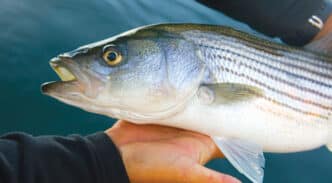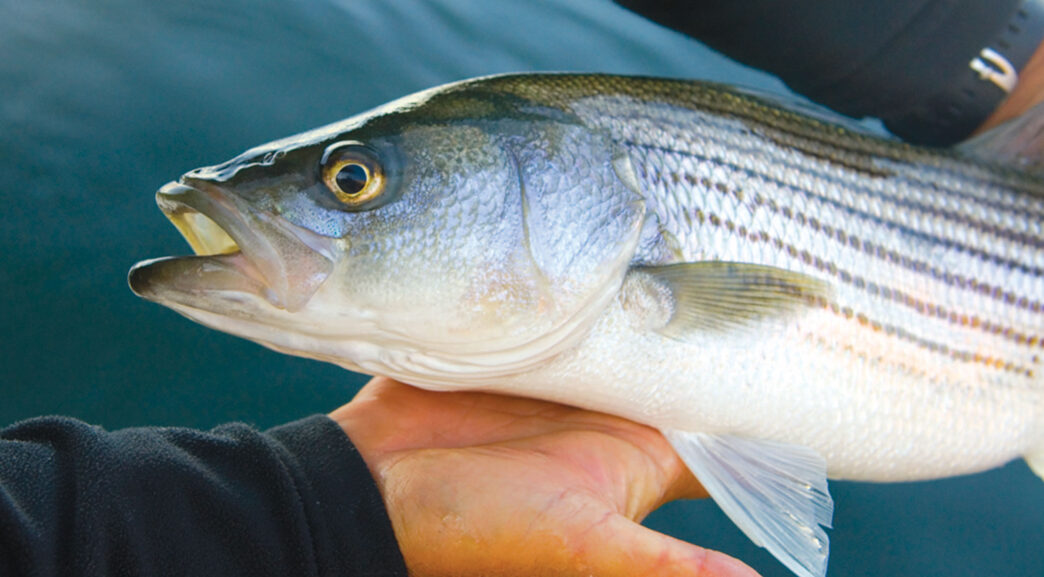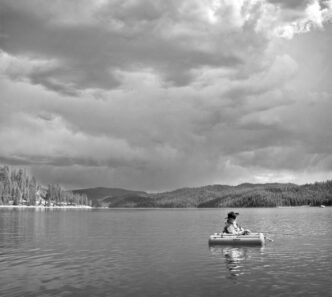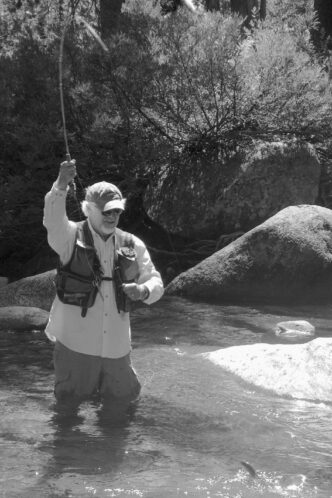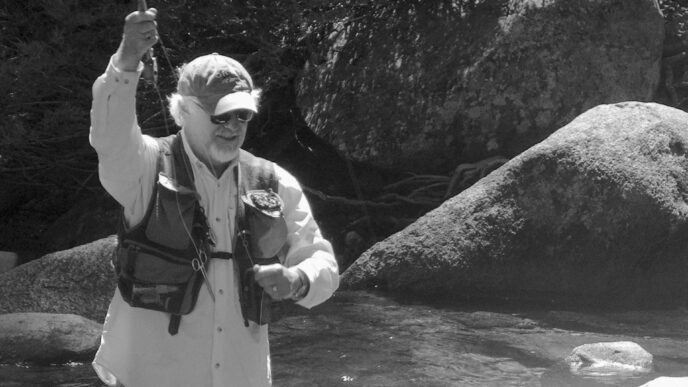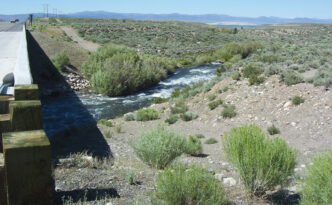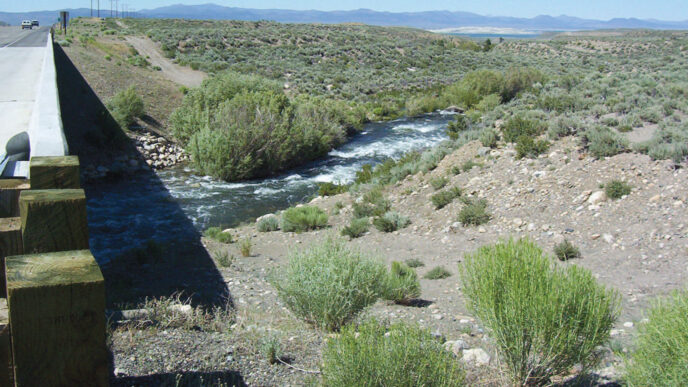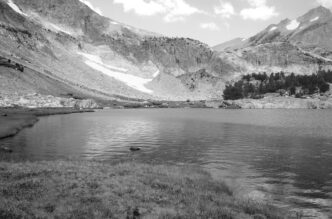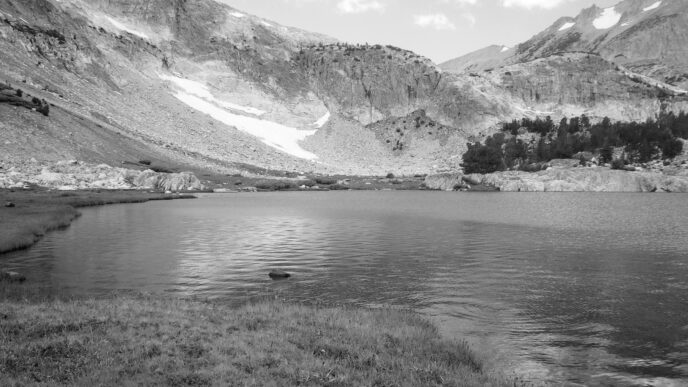I told Steve that I was avoiding all images of Lake Powell as we researched our May fishing adventure there. Neither of us had been to the lake, but both of us were captivated by the idea that one of our favorite fish inhabited this alien, yet auspicious body of water. In Lake Powell, the red Colorado River settles into an expansive, meandering impoundment with a shoreline exceeding the length of the entire West Coast of the United States. At this wide spot in its journey south and west, the Colorado drops its ochre sediment load, turns blue-green, and becomes the reflecting pool for a captivating Navajo landscape. Whatever one thinks about this Depression-era reservoir, contained by the walls of Glen Canyon and held by Hoover Dam, its beauty is undeniable. I wanted to see the lake for the first time in person, not in Internet or magazine pictures. As it turns out, my mind had other ideas. Images of both vast Southwestern landscapes and steep red-and-orange rock canyons inhabited my dreams for weeks before we left California.
Frank Bertaina told me about this fishery. He fished it years ago and said it was a striper fly fisher’s paradise. The fish are were not big, he learned, but their abundance was amazing. In a lake the size of Lake Powell, he said, the trick is to find them. I asked Frank what he thought of visiting the lake without a guide. He told me what he always told me about a new fishery: “Just go. You’ll know what to do.” Whether that was true or not, Frank appreciated that confidence never hurts in the game of fishing. When at his best, Frank never missed a chance to load up his friends with a big dose of confidence. Unfortunately, Frank, one of California’s great fly anglers, passed away earlier this year, but not before he inspired the trip that Steve and I were planning. Along with his many other friends, both of us will miss Frank.
Another friend, Dan Blanton, helped with knowledge that has served me very well over the years. In this case, he said that stripers are stripers. If you know them in the waters with which you are familiar, you know them anywhere. Steve and I do know stripers, perhaps more than we know any other fish. We understand how generous and how fickle they can be, but most of all, we know that striper fishing is often more hunting than fishing — and hunting stripers is our specialty.
As we left the Wahweap Marina store with our new Arizona and Utah fishing licenses, I stopped to ask a question of a couple who were chatting at a table outside the store. Steve’s boat sat a few feet away, loaded with our gear and waiting at the marina dock. “Excuse me, do you know about the shortcut?” I asked. “The shortcut” was a route that would allow us to run due north and up the lake, without following the river channel to the east and meandering through Antelope Marina, which was the long and slow route to the main body of the lake.
The woman smiled and asked where we were from. We told her we were from near Monterey Bay, and then we introduced ourselves. We had hit pay dirt. The couple, Wanda and Terry Eilts, before retirement, ran the San Juan Marina on the San Juan arm of Lake Powell, and they know the lake as well as anyone has ever known it. Terry is also an avid angler. They told us the shortcut was open.
Terry also told us the best place to start looking for smallmouth bass. “Tubes work best for smallies right now,” he said. “We brought only fly rods,” I responded. He paused, trying to figure out what he just heard, and then said, “That’s too bad.” Steve and I smiled. We talked for some time, and when we left, Wanda passed us a business card. I promised I’d drop her a note after we finished our trip.
On the way to Terry’s spot, as we slowly motored through the no wake-zone shortcut, I told Steve that I couldn’t believe we were here. “Yesterday at this time, we were pulling out of my driveway! Last night at 1:00 A.M., we were driving through Las friggin Vegas!” In this spectacular red-rock desert landscape, it was if we’d gone to Mars, and we had arrived with an open agenda for adventure and exploration. Steve was still in disbelief that all we did was pay an entrance fee at the Wahweap kiosk, park the truck, and launch his boat into another world: no camping fees, no plan with the Park Service needed to be filed. We were free! We had a vast expanse of stunningly beautiful water before us and, better yet, we had no restrictions.
We also had smallmouth bass attacking our flies! “I just had a hit!” I told Steve. It was my first cast into these new and strange waters, and I was already getting some attention! “I think it was a smallie, or at least it felt like one,” I said.
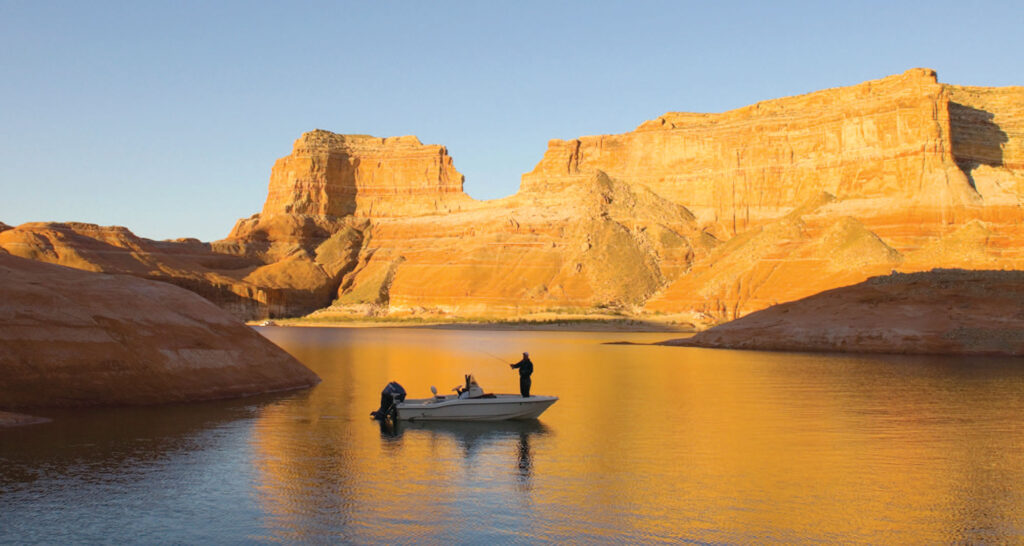
My first four or five fish were not large, but they weren’t small, either. They were strong, healthy bass that, like all smallmouths, never give up. Steve was using a weighted fly and not having the same success, but soon his rod swung to the side as he set up on something a little bigger. A deliberate fight ensued, and soon a mouth full of teeth, accented by a strange, milky eye, came up alongside the boat. With one look at those teeth, I reached for the Boga Grip and weighed the fish in at four pounds. This was the first walleye that Steve and I had ever seen, and the flesh of this species is legendary as among the best eating of all the freshwater fish. We immediately filleted Steve’s catch and placed it on block ice. As a midmorning meal the next day, coated with panko crumbs and fried in oil over a Jetboil stove, there could not have been a better Lake Powell breakfast.
Guilt over harvesting fish was not something Steve and I experienced at Lake Powell. This fishery is exceptionally well managed. In fact, our main target, the striped bass, is so abundant there that there is no bag limit. Wayne Gustaveson manages this fishery for the State of Utah, and its fish are not only his charge, but his obsession. Further, the lake’s size makes overharvesting a virtual impossibility. The management challenges at Lake Powell derive from an overabundance of predatory fish, not an overabundance of predatory fishers. The forage base for the aggressive piscivores inhabiting Lake Powell is threadfin shad. Keeping this protein source ubiquitous is essential to the survival of the reservoir’s game fish. With the exception of crappies and largemouth bass, which fluctuate in population due to issues related to lake level more than other factors, the bag limits on all of Powell’s game fish are generous, and they need to be to keep the threadfin shad numbers as stable as possible. If management strategies interest you, I strongly suggest you visit Wayne Gustaveson’s website, www.wayneswords.com. Here you can find out more about how diligently managed Lake Powell is by this forward-looking biologist and obsessed angler.
Our first real initiation into the nature of this new world occurred when we were awakened at 1:30 A.M. to a blast of wind so sudden and violent that it felt as though the tent was being buffeted like a plastic grocery bag in a hurricane. It stopped just as suddenly. We both walked outside the tent into warm, nearly tropical air and a scene so bizarre I will never forget it. The moon’s light was penetrating low, dense clouds just enough to light the red-rock world around us, and the weirdly colored light was reflected back on the low clouds. The sky, the air, the entire world within view of our little beach was oddly tinted and unlike anything either of us had ever seen. You could not make out any details of the larger world, but the soft outlines of the boat, secure and anchored three ways to shore, was visible through this thick red haze. My dream images could not compare with the reality of this scene. Steve and I were amazed at the sight.
April and May can be the very best months to visit Lake Powell. They can also be the worst months. The upside to a spring visit is the potential for both outstanding fishing and perfect weather and temperatures. Add the fact that use of the lake is light in the spring relative to the high summer season, and Powell can feel like a paradise set aside for you alone. However, should the wind blow, spring winds can lock you down. During a big blow, even in a sheltered cove, you can expect to eat the wind and blasting sand. This is obviously not much fun for fishing, dining al fresco, or even sleeping.
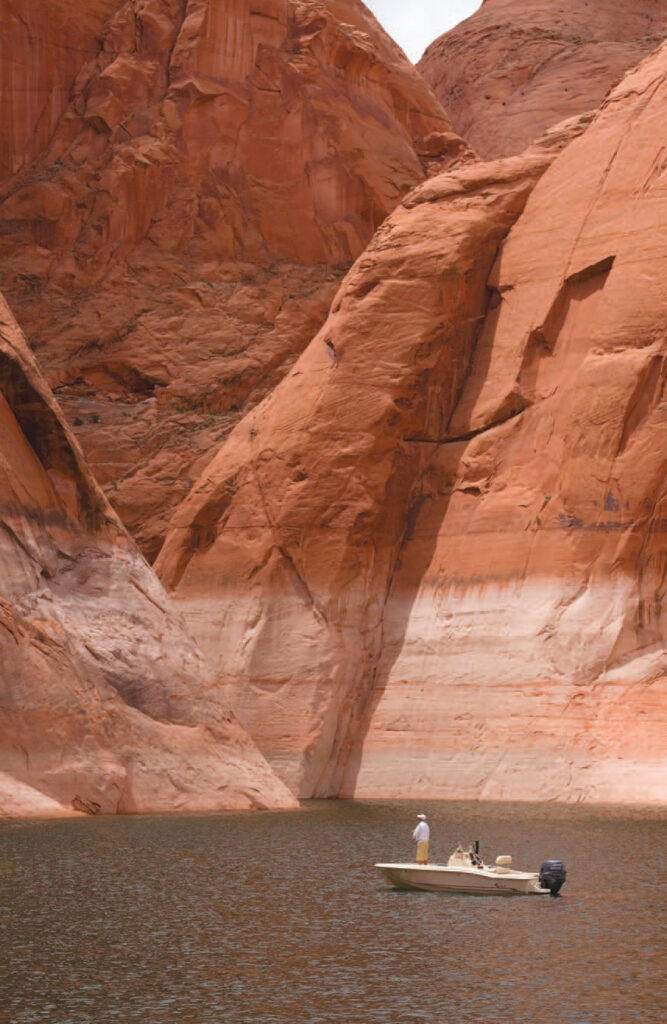
The wind is also the reason that Lake Powell is not a place for a small boat or an inexperienced boater, especially in the spring. Steve’s boat is a very seaworthy 18-foot Scout, and on our second day, the wind gave us as much rough water as we have seen 30 miles out in the Pacific Ocean. Steve and I know better than to put ourselves in unnecessary danger for the sake of recreation, so we picked our way through the big water and fished in the calmest, most sheltered water we could find. The fishing was fair, but I can’t say it was all that much fun. Regardless, as we worked our way farther north into the lake, around every corner was a new, spectacular landscape. We finished our day at the protected end of Gunsight Bay and with the evening, the wind settled down and the smallmouth fishing turned on.
“Well, that’s a familiar face!” I said to Steve as he lipped the first striper of the trip. It was our third day, and we were into some fun fishing tight to shore for very large smallmouth bass in placid water. Then, near a submerged rock hump, we got into our first stripers. These were small fish, but they had an appetite for big flies. They were also the reason for our trip, and we were thrilled to see them. We caught a few more, but due to their small size, we turned our focus back to big smallmouth bass.
By midday, though, we were ready to see more and bigger fish of the striper variety, so the hunt began. We went back to camp, packed our gear, and headed to Padre Bay, the next big bay to the north.
There were rumors of stripers present in Padre Bay, but the reports were inconsistent, and the word was that if you did find fish, they would not eat. The weather was perfect for the hunt, though, and Steve and I immediately saw the place we wanted to begin our search when we entered Padre. Across from a stark bluff known as The Cookie Jar, we saw a small, scalloped bay with broken rock and partially submerged brush littering the shoreline. We scoured the bay with long casts using LC-13 lead-core shooting heads attached to monofilament shooting line. About halfway across the cove, we doubled on stripers, and these were bigger fish. They were not trophies, but were powerful schoolies in prime health, and they worked our 9-weight rods into deep bends. Soon we zeroed in on a small school and proceeded to catch a striper every cast, but the action was short-lived. Although we were thrilled to find action on strong schoolies, we felt as if we were near the mother lode, but not had not yet tapped it.
After an hour or so, we decided to set off exploring the sights for a while. The best excuse for which direction to go was our need to gas up, so we charted a course for a marina north of us called Dangling Rope. The water was glassy, and the ride left us slack-jawed. Each bend in the river channel brought with it a new view of the lake and another stunning arrangement of rock, water, shadows, and reflections in every shape and hue imaginable. We also realized the futility of fully experiencing this amazing lake on a one-week trip. As we zigged and zagged our way north, canyons to the east and west begged for exploration. Their beauty and their structure overwhelmed me as both an artist and an angler. Steve just shook his head in disbelief. This was a version of heaven, as inspiring in midday light as it was surely to become spectacular as the light angle steepened and the colors warmed with the onset of evening.
After running our errands and taking in more of the lake, we made our way back to Padre and our camp. As we motored on calm water to the rear of Padre Bay, I told Steve to stop the boat. “Do you smell that bait?” I asked, then said, “Wait, that’s not bait, it actually smells like spawning white bass.” We both know that thick scent well from years of fishing the Lake Nacimiento Narrows during the spawning run for the cousin of the striper, the white bass. We followed the scent upwind. There was barely a puff, but that was enough to carry the scent. We ended up against a sheer cliff — not exactly prime habitat for stripers. “Man, this place smells exactly like Naci.” Steve said, followed a few seconds later with “Oh . . . my . . . GOD!” I looked over at him, and he looked at me, then slowly pointed down. I peered into the water, and the sight was astonishing. Hundreds of bass were shoaled up under the boat, moving along the wall. They were all moving the same direction, and soon we realized we were not looking at hundreds, but rather thousands of fish — many, many thousands of stripers!
We watched for a while, then grabbed the rods. After we cast, we set up on nearly instant doubles. The best thing was that we were watching the fish eat. We tossed to the wall, hitting it with our flies, watched the flies slide into the water, then stripped them in. With each cast, from a mass of fish, a small group would stand out as they swam crosswise over the school and right behind the fly. In all honesty, at a distance, we did not exactly see the “eats,” but we saw the fly disappear and the lead fish turn, then felt the line tighten as the hook found its mark.
The takes ranged from subtle to bone-jarring, but these fish were on the job, and we were having a blast. This action continued well past sunset, and we mixed it up by working new spots on the wall, fishing deeper, fishing toward the shore, fishing out from the shore while tight to it, and experimenting with many different flies and retrieves.
We ultimately found that longer leaders worked better, which is odd for stripers. Unweighted flies were better than weighted, and a “teasing” retrieve was essential to prompt a take. When the bite was subtle, what we called the “ignore the fish” approach seemed to do the trick. We just kept stripping on the soft take until the line grew heavy, and then, only after the line nearly came tight, did we strip and swing the rod for a hook set.
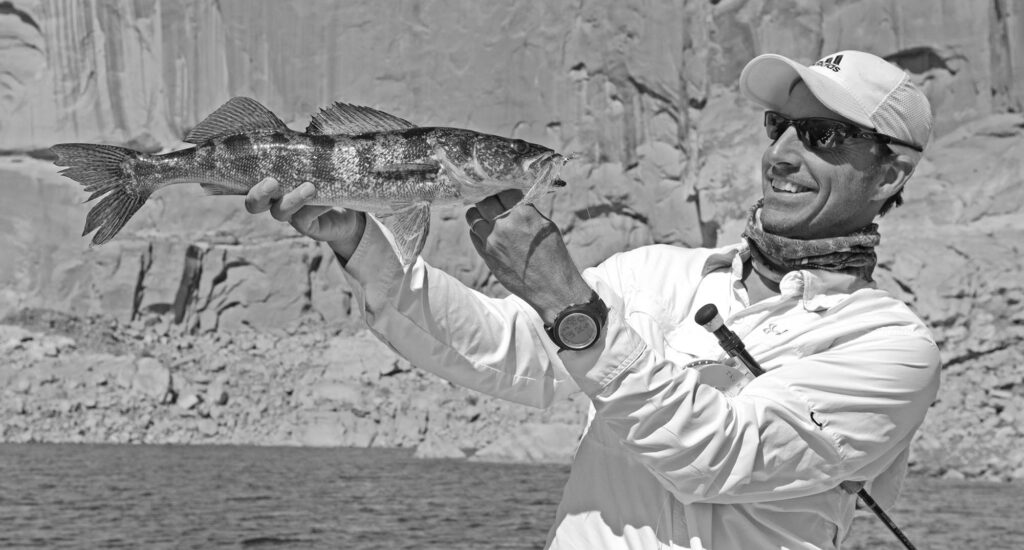
If one wanted to claim monotony in this fun, it would be in the fact that all of these fish were around the same size, but what a perfect size for fast-action striper fishing! Few were smaller than three pounds, but equally scarce were fish above five pounds. Nevertheless, the power in these strong schoolies defied their size. You could tell at a glance that these fish were prime specimens, showing off their perfect condition. They had wide flanks and deep bodies with round bellies. Their backs were dark green and copper, and their stripes were laser straight . . . every one of them. The bend they forced on our 9-weight rods was a testament to their condition. By nightfall, the sore spot created on our sides by the fighting butts on our fly rods was a painful, but welcome souvenir from the evening’s encounter with these powerful game fish. We called it a striper sunburn.
I’ve never been a fan of slow fishing, and when I encounter those who seem disappointed that a fishery is somehow less enjoyable because it is too easy, I often feel compelled to point them in the direction of tough fishing, as if that might be more to their liking. However, there was a limit to how long Steve and I could stand catching these schoolie stripers in the same spot. The threshold turned out to be two and a half days and many hundreds of fish. But if it were just the fishing, we would likely have pursued other situations sooner.
As it turned out, part of the joy of the fishing at Padre Bay was the arrival of a fair number of gear anglers eager to get in on the fun. What led to this unforeseen companionship was an encounter with Wayne Gustaveson. He was out scouting Lake Powell for giant prespawn schools of striped bass, and we just happened to be sitting on one. Wayne was preparing for an event later in the week called the Shad Rally. This event was conceived of by Wayne as a fun way to control striped bass numbers at a time when they are highly concentrated during the spring spawn. When we first saw Wayne, we did not know who he was, but we were eager to talk to other fishers. We had been completely alone for the last several days and welcomed the company. Wayne approached us on the water and asked us if we had seen any stripers. At that moment, we were sitting down in Steve’s boat taking a break. In response to his question, we both pointed down. He looked at his graph and caught his breath. I think he said, “Oh my.”
Suffice it to say that we expected what followed the next day and surprisingly found it to be a whole lot of fun. By 10:00 A.M., at least 10 boats were near us, and Steve and I got to show off. Very few people fly fish Lake Powell for striped bass. Many of the anglers in the boats around us had never seen fly fishing on the lake. By the time they saw us, we had completely cracked the code on catching these fish, no matter their depth. At first we heard a lot of quiet talk, such as, “Jeez, they have doubles again!” or “I did not know that was possible with a fly rod!” and so on. That was fun for a while, but at a party with strangers, something had to happen to break the ice. The stripers took care of that. Soon, everyone started catching fish, and we all began sharing comments and accolades on our fishing prowess, knowing full well that it was simply good luck and hungry fish that got this party started. Before long, everyone knew everyone else’s names, and we were all having a ball.
All the fun aside, soon enough we had our fill of socializing, and it was time for us to find new fish in new water on our own. We went to Navajo Canyon to finish off our week-long adventure, because it is known as a beautiful canyon and was on the way back to the launch at Wahweap. In the back of Navajo, turbid stream water meets clear lake water. It was here that we located several more large schools of striped bass. The fishing was a bit slower, but was interesting because the river canyon created a varied shoreline with constantly changing views and targets for the fly. The action was fast at times and then would shut off, so we moved from one spot to another. The beautiful scenery made even inconsistent fishing a thoroughly fulfilling experience.
Another experience added to the enjoyment. In casting to a fresh spot along a steep wall, I stripped the fly in about 10 feet, then hovered the fly. As I began to strip again, the fly stopped as if it had hit a brick building. The rod bucked and the line popped as a massive fish began a deep dive and rapid run to the right. I smoothed out the popping line as best I could. I told Steve that it felt as though I hooked a cinder block. After this fish’s short burst, it stopped and began shaking its head. This confirmed for me that it was big, was fair hooked, and was a striper. However, I always hold my breath when a big bass shakes his head. I kept the line tight, but at a steep angle with a bent rod, the fish had the advantage. The line went limp, and he was off. “ WOW!” I said, and started laughing. Having caught enough trophy bass himself and seeing what that one did to the rod, Steve looked at me and said, “Well, that was interesting!”
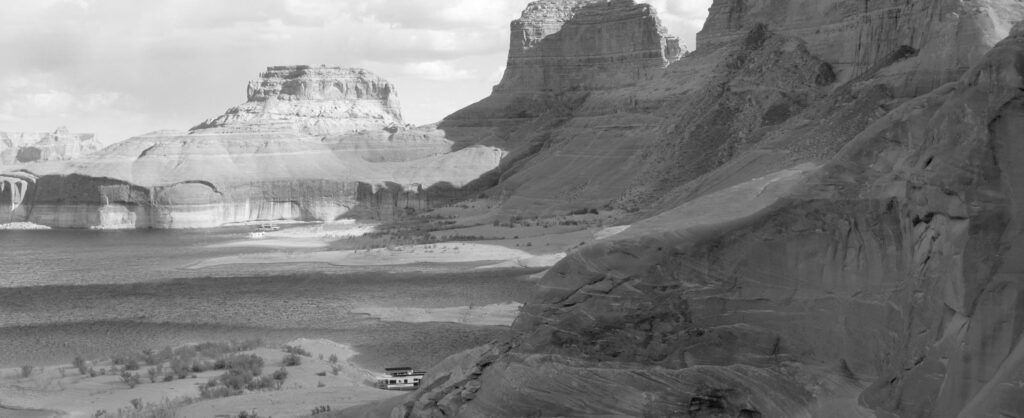
We agreed that this was probably the best possible way to end a completely enchanting week. Neither one of us could conceive of a better excuse to return to this wonderful place than knowing this big bass will be waiting for us. We fished the next morning then headed for the ramp.
After I returned home, I did write Wanda a note. Her response to my euphoric e-mail was to say that she looked forward to seeing me soon. As I write this, I’m finalizing plans for a fall return in my boat, Juney.
I cannot wait to see Lake Powell in autumn light and to enjoy more adventures so close to home and yet unlike anyplace the California fly fisher can experience here in our state. It won’t hurt that fall is also when Lake Powell stripers begin their most aggressive surface feeding. I’m reaching for the lake map now.
If You Go…
My experience with Lake Powell is limited, but I did learn some important things that might make your visit more enjoyable. First, be sure to visit www.wayneswords.com for a wealth of information on everything from current fishing conditions, to what to expect weatherwise, to detailed information on marinas, camping, houseboating, and fishing regulations. Wayne Gustaveson has not only assembled a tremendous amount of information on his Web site, he has also attracted a helpful community of anglers and boaters to his discussion board. Here you can find answers to virtually any question almost immediately. The regulars on his board are not only knowledgeable, but eager to help new visitors to the lake.
Specific to my visit and to shore camping in general, the best advice I can offer is to view shore camping as similar to backpacking in that traveling light is the best way to make your trip enjoyable and your boat most effective on this higher-elevation lake. Bring a tent, a light sleeping pad, a portable stove, and a water filter. You are also required to know the rules on personal waste. Also, be prepared to have your boat and trailer inspected before launch due to concern over invasive mollusks. This is not a big deal at all. Just be sure to wash your boat thoroughly before your trip, including the bilge and storage areas. A spotless boat will pass inspection quickly and easily. Visit www.nps.gov/glca for more information on park regulations. Finally, remember that Lake Powell is not for small boats. It can be treacherous. If you boat is not capable of handling oceanlike conditions, it is not a good candidate for this body of water.
For houseboating, boats can be rented at Antelope Point, Wahweap, and Bullfrog Marinas. Compared with Lake Shasta and other popular houseboating lakes in California, Lake Powell is more expensive. Dividing the cost among several anglers will make houseboating more affordable, and several skiffs can be towed behind a houseboat. Some of the rental houseboats are lavish, so if luxury accommodations are a must, houseboating is your best bet. For families, houseboating is also the most convenient option. Both Steve and I agreed that if you have a young family and can share a boat with another family, you might very well have one of the most memorable vacations of a lifetime, with excellent fishing as a bonus.
For fishing gear, Steve and I kept it simple, but we still covered all the bases. We brought three rods each: A 6-weight for smallmouth bass, a 9-weight for stripers, and an 8-weight for top-water fishing with a floating line. For lines, we mostly fished fast-sinking T-8 tungsten shooting heads on our 6weights and LC-13 lead-core heads on our 9-weights. However, we also brought along a spare reel for each rod with intermediate lines for shallow-water fishing. For flies, Clousers and Deceivers will do the trick. I also used rear-weighted flies and had great success, but the more important distinction seemed to be between weighted and unweighted flies. Many times, unweighted flies seemed to perform better, but not all the time. Experimentation will be your best guide here.
During the late spring and summer months, top-water fishing for striped bass begins to turn on. This lasts through the fall and can be outstanding. Be prepared with a range of fly patterns and sizes imitating various size classes of threadfin shad.
Be sure to inspect both your boat and your trailer as you prepare for this adventure. Make sure your safety gear is up to date, your motor is tuned and in excellent working order, your electronics are fully functional, and your trailer is road ready, including extra hubs, bearings, and at least one spare tire if you are traveling far. But most important, bring along a great attitude and realize that the weather is not always going to be perfect and that the fish don’t always bite. One thing is for sure, however, and that is that Lake Powell is one of the most enchanting and beautiful places in the world to wet a line, and it’s easily accessible to the California fly fisher.
Dave Sellers



